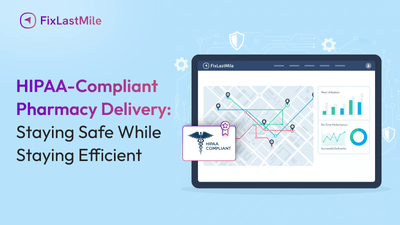Excel has been the backbone of courier route planning for years. It’s familiar, it’s simple, and it seems to get the job done.
But here’s the truth most UK courier managers whisper under their breath: “It’s eating my mornings alive.” Every day starts with the same routine: endless rows, address sorting, driver allocation, and last-minute edits. The hidden cost to it is: Time lost, mistakes unnoticed, drivers waiting, customers unhappy.
Across the UK, courier firms are realizing that spreadsheets can’t keep up with the speed their customers expect. And if you run a UK courier business and you’re still using Excel, you’re paying in hours and pennies you don’t see.
That’s why many businesses are switching to smart, AI-driven route planning software that plans in minutes, adapts in real-time, and actually saves money.
In this blog, we’ll unpack why Excel is holding courier firms back, what AI is doing differently, and how the shift is transforming delivery operations nationwide.
Let’s begin by understanding the reality of Excel’s route planning.
The Reality of Excel Route Planning
Most courier firms in the UK still rely on Excel or similar manual systems to map out delivery runs.
That one sheet becomes the driver of your daily operations. You manually key in addresses, sort stops, allocate drivers, and hope nothing changes.
But in the delivery world, nothing stays static. Traffic, cancellations, last-minute orders, and weather, Excel doesn’t adapt. This results in delays creeping in, driver idle time grows, and customer satisfaction dips.
Using a spreadsheet for daily route planning may feel familiar, but it imposes hidden burdens like:
- You spend hours each morning just organizing data instead of executing deliveries.
- Your planners become jugglers of stop-lists instead of strategists of efficiency.
This means you miss out on what a purpose-built route planning solution for courier deliveries can deliver: speed, accuracy, and adaptability.
The True Cost of Manual Route Planning
When you look beyond the obvious, Excel routing is expensive. Let’s break it down with your cost lens.
Assume your planner spends ~2 hours each morning constructing delivery routes using Excel. That’s ~10 hours per week. If you pay £20/hour, that’s ~£800 per month for one planner.
And when you multiply this by two or three planners, it quickly becomes four figures monthly. That’s time and salary wasted.
But the cost doesn’t stop there.
-
Mistakes in sequencing add mileage.
-
Inefficient routing means more fuel burn, more driver time, and more wear & tear, affecting margins.
-
Delays, missed windows, and dissatisfied customers lead to reputational costs you can’t easily measure.
If you continue using Excel, you might think the cost is zero because Excel is “free”, but every hour lost, every inefficient route planned is a cost.
How AI-Powered Route Planning Works
The good news is, there’s a smarter alternative to the Excel route planning.
A true AI-powered route optimization software shifts you from manual to automated, from reactive to proactive.
Here’s how it works in plain terms: your system feeds in delivery addresses, driver availability, vehicle capacity, time windows, and traffic data. Then the solution calculates the most efficient routes within seconds (through AI). When you integrate this system with real-time data, it even adapts quickly.
Let’s walk you through the elements of a modern UK courier route planning software.
-
It imports orders automatically (no manual entry).
-
It considers live traffic, vehicle capacity, and driver shifts.
-
It assigns each stop to the right driver, at the right time.
-
It provides a mobile driver app so drivers follow optimized routes.
-
It updates when something changes: cancellation, delay, or new stop.
In short, it’s not just planning; it’s intelligent planning.
The result of this is:
-
You free your planning team’s time
-
Your drivers operate smarter, and
-
Your customers receive better service
For UK courier operations, this becomes a differentiator.
Excel vs AI: Head-to-Head Comparison
Let’s put Excel and AI-based routing side by side so you can see how stark the difference is for a courier firm.
| Parameter | Excel-Based Route Planning | AI-Powered Route Planning |
|---|---|---|
| Time to plan routes | 2–3 hours daily | Less than 10 minutes |
| Adaptation to live changes | None or very limited | Real‐time rerouting |
| Data input | Manual entry of addresses, stops | Automated feed from order management |
| Error risk | Human error high | Minimal with automation |
| Cost efficiency | Low: hidden costs, high | High ROI via efficiencies |
| Scalability | Hard to scale, labor increases | Easily scalable as volumes grow |
| Driver visibility | Very limited | Live tracking, updates |
| Proof of delivery and analytics | Disjointed or manual | Built-in dashboards, insights |
When you compare the two, it becomes clear: sticking with Excel means you’re accepting inefficiency.
And in a competitive UK courier market, inefficiency means you’re giving away margin and market share.
Real Example: A UK Courier’s AI Transition
Let’s take the example of a mid-sized courier firm operating in Manchester. For five years, they used Excel to map 50 daily delivery runs. Their planning team spent about 3 hours every morning planning. Fuel costs were creeping up 18 %, and on-time performance hovered around 82 %.
Then they implemented a dedicated AI-powered route planning software for UK courier companies.
Within three months, they saw
-
Planning time dropped to 15 minutes daily
-
Fuel costs reduced by 18 %
-
On-time deliveries climbed to 94 %, and
-
Their drivers reported less idle time
Their operations manager said, “We stopped chasing spreadsheets and started focusing on service.”
This isn’t an isolated example; many UK courier firms adopting intelligent routing are seeing similar uplifts. When you replace manual with automated ones, you change the game.
Why UK Courier Firms Are Leading the Switch to Smart Route Planning
Many UK courier firms are seeing the adoption of smart route planning effectively. But why is this shift happening in the UK right now?
A few strong reasons for this switch are:
-
Labor costs in the UK are high and rising. Plus, time is money, so optimizing time is critical.
-
Fuel and vehicle running costs are under constant pressure from drivers, fuel, and maintenance.
-
Customer expectations are tougher: same-day, next-day deliveries, live tracking. If you miss the mark, you lose business.
-
Competition is fierce: If you’re slower or less transparent than the next firm, you fall behind.
-
Technology is mature: modern route planning solution for courier deliveries are accessible, SaaS-based, and integrate with your operations seamlessly.
In fact, the global delivery management software market is projected to grow by $666.7 million from 2024-2028, and the UK is firmly on the growth path.
UK courier firms making the switch aren’t early adopters. They are the next wave of business transformation. You can either jump in or risk falling behind with Excel.
What You Should Look for in Route Planning Software
If you’ve decided it’s time to move on from Excel (and you should), here’s a quick checklist to evaluate a route planning solution for courier deliveries.
You should look for:
-
Automated order importing and integration with your systems.
-
Real-time route optimization taking into account traffic, cancellations, and capacity.
-
Driver mobile app with live tracking, updates, and proof of delivery.
-
Dashboards & analytics so you see cost, performance, and missed stops.
-
Scalability: the solution should grow with your delivery volume.
-
Strong UK support and local context (because UK roads, regulations, and customer expectations matter).
-
ROI you can measure (reduced planning time, improved on-time deliveries, lower fuel costs)
Bottom line: If your current setup is Excel + handwritten notes + driver calls, it’s time to upgrade.
Conclusion
If you’ve been relying on Excel to plan your courier routes, you already know how draining it can be. It works; until it doesn’t. One wrong formula, one last-minute order, and suddenly your whole plan falls apart. The truth is, spreadsheets were never built for the pace of modern courier operations.
But, AI-driven route planning is a different story. It saves hours, cuts costs, and keeps you in control even when things change on the road. That’s why so many UK courier firms are making the switch. They’re not chasing trends; they’re choosing efficiency.
That’s where FixLastMile comes in. Our intelligent route planning and optimization software is built specifically for UK courier companies. It helps you cut planning time, reduce costs, and deliver with confidence every single day.
Ready to move beyond spreadsheets? Let FixLastMile help you plan smarter and deliver better.
Want to make faster route planning and speed up the deliveries?
Frequently Asked Questions (FAQ's)
It’s a digital tool that helps UK courier firms plan, optimize, and track delivery routes automatically, saving time, cutting fuel costs, and improving daily delivery efficiency.
Most courier firms reduce planning time from 2–3 hours to under 10 minutes daily. This frees teams to focus on growth and customer satisfaction instead of spreadsheets.
Absolutely. Even small courier firms benefit from automating manual planning, improving route accuracy, and scaling operations without extra staff or complexity.
There’s an initial investment, but savings in time, fuel, and labor quickly outweigh it, thereby delivering measurable ROI within the first few months of use.
Yes. AI-based systems reroute drivers instantly based on live traffic, cancellations, or delays while keeping deliveries efficient and customers informed in real time.




